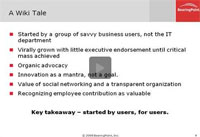The final part of our video series with the Financial Times, features John Gill, BearingPoint managing director. John begins by discussing how organizations can manage risks by utilizing dashboards to deliver the right risk indicators and meaningful insights. He also explores why data warehousing projects fail and what can be done to accelerate business intelligence including utilizing BearingPoint’s Rapid Execution dashboard methodology. Finally John covers the need for a data dictionary, utilizing active dashboard and the biggest information challenges for organizations.
Thinking Archive
- May 2009 (2)
- April 2009 (7)
- March 2009 (5)
- February 2009 (5)
- January 2009 (6)
- December 2008 (8)
- November 2008 (4)
- October 2008 (10)
- September 2008 (8)
- August 2008 (5)
- July 2008 (6)
- June 2008 (9)
- May 2008 (10)
-
Recent Posts
- Identifying and measuring the value of customer-centricity
- How the wealth management industry is in position to benefit from today’s economic climate
- What Drives Merger Integration? Experts Reveal What Your Organization Needs to Know
- Drug safety with a comprehensive risk management strategy
- Information Management: Tom O’Toole interview
- Atlassian banking BearingPoint Brian Hart business intelligence business transformation CFO change management Chief Information Officer CIO collaboration compliance confluence cost management cost reduction cost takeout credit crisis CRM data management data security data storage desktops Enterprise 2.0 enterprise information Enterprise Wiki environment Facebook finance financial services Financial Times going green governance green data center green IT HR IM Leaders information information management information sharing information technology insurance IT IT costs Jay Hariani Larry Taylor life sciences market survival Matthew O'Mara Nate Nash operational costs outsourcing performance improvement performance management Peter Horowitz podcast Podcasts privacy regulations risk risk management Sandeep Vishnu SAP SAPPHIRE Sean Lew SOA supply chain survey Surveys technology transformation transparency virtual desktop virtualization wiki wikis
Top Clicks
- None
May 2008
Top Posts
- Identifying and measuring the value of customer-centricity
- How the wealth management industry is in position to benefit from today’s economic climate
- What Drives Merger Integration? Experts Reveal What Your Organization Needs to Know
- Drug safety with a comprehensive risk management strategy
- Information Management: Tom O'Toole interview
- Information Management: Mark Coughlan interview
- Information Management: An interview with Tom Conophy
- Supply Chain Calibration for Consumer Goods
- Sweeping Insurance Industry Change
- What the Savings & Loan Crisis Taught Me about Public Trust



 Information is the backbone of life sciences organizations. When used
Information is the backbone of life sciences organizations. When used